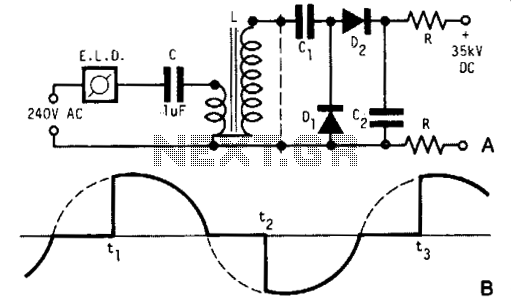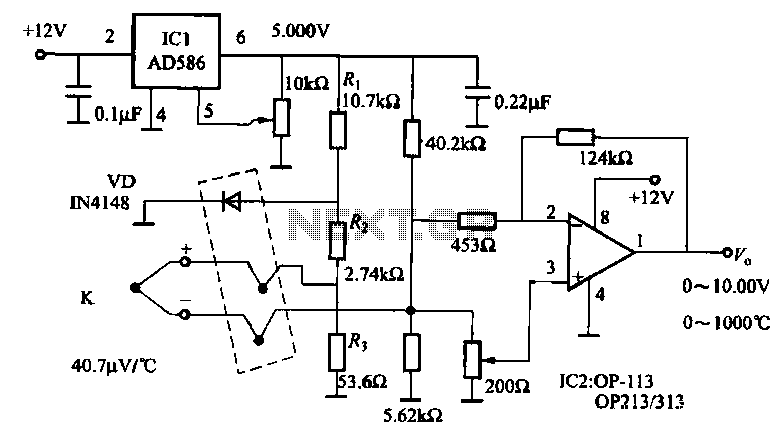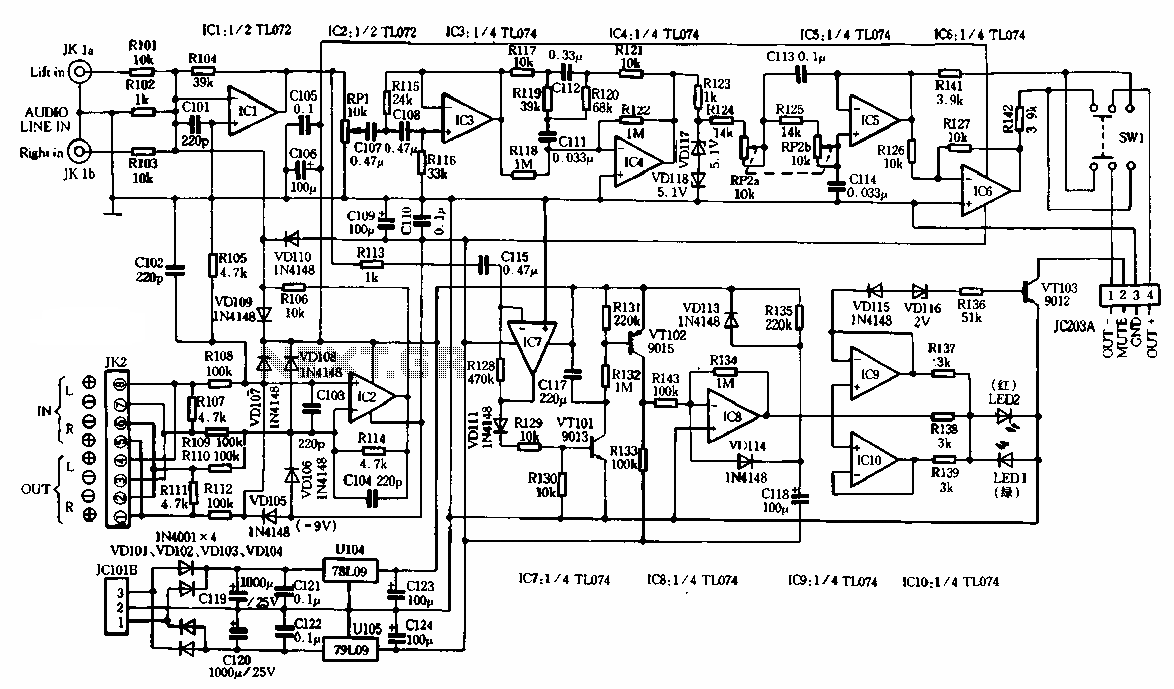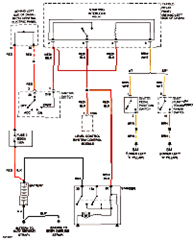
power supply circuit
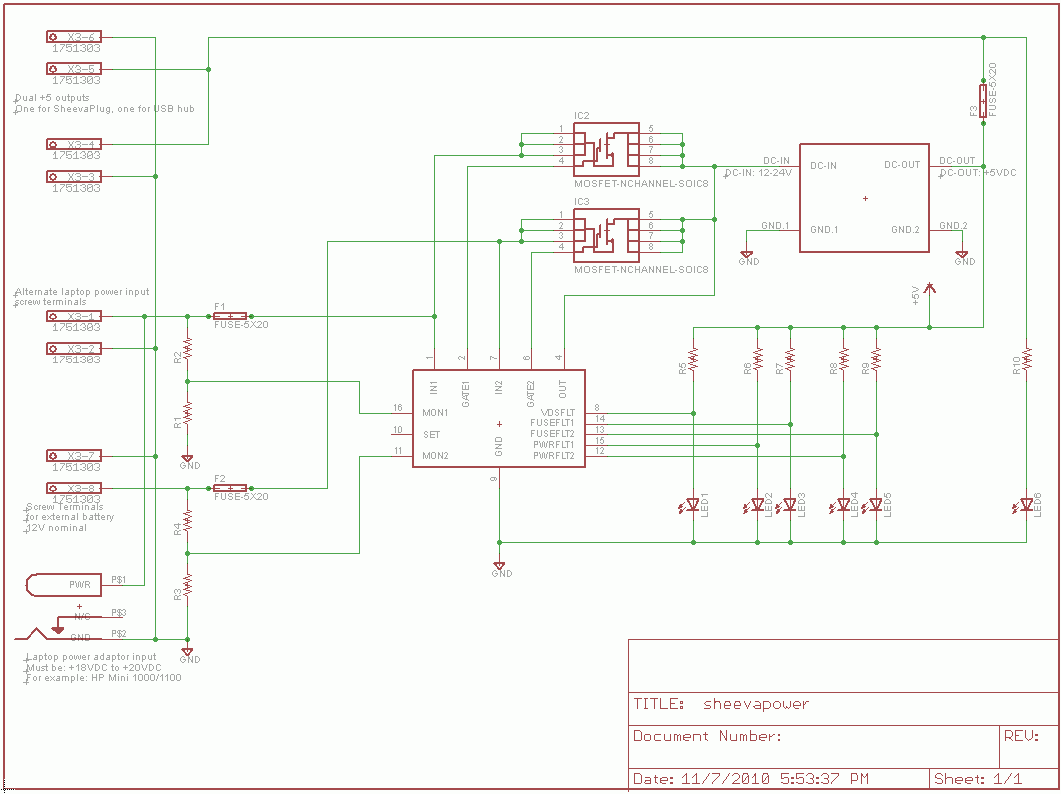
The SheevaPlug is known to have a suboptimal power supply, particularly affecting users in the UK operating at 240VAC. Additionally, heavy loads on the USB can cause issues, especially when connecting an external mechanical disk drive. This project aims to address multiple challenges: the circuit's premise is straightforward. The SheevaPlug, USB hub, and laptop hard drive all require 5VDC for operation. A DC-DC converter is employed to supply +5VDC for the entire system. This converter is designed to accept input power ranging from 11-24VDC and convert it to a stable 5VDC output. The circuit requires two distinct power sources to feed the DC-DC converter. The primary source is 120VAC house wiring via a standard laptop power adapter, while the secondary source is a 12V lead-acid battery. The laptop charger was selected for its availability, efficiency, compact size, and output voltage of at least 18 VDC. A replacement charger for an HP Mini 1000/1100 netbook was procured, which is a 30W adapter providing 19VDC at 1.6A. It features a 4.0mm connector with a 1.7mm center pin, where GND is connected to the barrel and V+ to the center pin. A replacement HP Mini 1000 adapter was acquired for under $10, including shipping. The backup power from the lead-acid battery is delivered as 12VDC. Even with a charger connected, the battery voltage remains below 18 VDC. A high-quality charger will be used to prevent overcharging. This allows the battery to remain connected to the charger without the risk of excessive water loss. The initial circuit design combined the two power sources using a pair of Schottky diodes, which is a simple and cost-effective solution. However, Schottky diodes are inefficient at low voltages, with a typical voltage drop of about 0.5V. The SheevaPlug and disk together draw approximately 8W at 5V. With a 12V supply and assuming an 80% efficiency for the DC-DC converter, 0.8A would flow through the diode. This results in a power loss of 0.4W across the diode, which is significant when considering that the idle power of the hard disk is also 0.4W. To improve efficiency, "Ideal Diodes" were identified, which utilize a controller IC to drive a MOSFET, functioning similarly to a diode without the associated voltage drop. The chosen MOSFETs were IRF7469 N-channel MOSFETs, featuring a resistance of 17 milliohms. This means that with the same 0.8A current flowing through the FET to the DC-DC converter, the power dissipated in the FET would be only 0.011W, approximately 1/40th of the loss seen with the Schottky diode approach. The new controller circuit employs an LTC4355 controller to merge the power inputs from the two sources. This controller can detect various system faults, including undervoltage on inputs, blown fuses, or faults in the MOSFET drivers. Consequently, the two power sources are combined through the ideal diode controller ASIC. In simple terms, this setup ensures that the power source with the highest voltage will supply the DC-DC converter. The laptop power adapter's voltage output is intentionally set higher than the maximum voltage from the battery, even during charging, ensuring that the laptop power adapter provides the system's power whenever it is connected.
The circuit design incorporates a DC-DC converter with a wide input voltage range, ensuring compatibility with both the laptop power adapter and the lead-acid battery. The LTC4355 ideal diode controller is crucial for optimizing power management, enhancing efficiency, and providing fault detection capabilities. The use of MOSFETs instead of traditional diodes significantly reduces power loss, which is essential for maintaining system efficiency, especially under load conditions. The integration of these components creates a robust power supply solution designed to operate reliably in environments with fluctuating power availability, such as during winter storms that may disrupt electrical service. This approach not only ensures stable operation of the SheevaPlug and connected devices but also maximizes the use of available power resources, enhancing overall system performance and reliability.The SheevaPlug is reputed to have a marginal power supply. It seems to be more of an issue for the people in the UK running at 240VAC, and it also seems to be a problem to load the USB too heavily, as happens if you want to add an external mechanical disk drive. Add to that, the fact that I live in a part of the world where the power is pretty unr eliable in the winter. Storms knock down trees and they take the power lines with them. This project attempts to kill three birds with one stone: The premise of the circuit is simple. The SheevaPlug, USB hub, and laptop hard drive are all designed to operate on 5VDC. The circuit utilizes a DC-DC converter to provide +5VDC for the whole system. The DC-DC converter is designed to take input power in the range of 11-24VDC and convert it to a constant 5VDC output. The only bit of trickiness is to arrange for two separate sources of power to feed the DC-DC converter.
The main source comes from 120VAC house wiring through a standard laptop power adaptor. The backup source is from a 12V lead-acid battery. The laptop charger was chosen for easy availability, efficiency, small physical size, and a voltage output of at least 18 VDC. I got a replacement charger for an HP Mini 1000/1100 netbook. It is a 30W adaptor that puts out 19VDC at 1. 6A. It uses a 4. 0mm connector with a 1. 7mm center post, where GND is on the barrel, and V+ is on the center pin. I got a replacement HP Mini 1000 adaptor on eBay for under $10, shipping included. The battery backup power arrives in the form of 12VDC from a lead-acid battery. Even with a charger attached, the voltage across the battery is less than 18 VDC. I will be using a high-quality charger that does not overcharge the battery. In practical terms, this means that you can leave the battery on the charger permanently without cooking all the water out of it.
My first attempt at the circuit combined the two power sources through a pair of Schottky diodes. That is simple, cheap, and works. The problem is that diodes are kind of power inefficient at low voltages. The Schottky diodes drop about 0. 5V across them. The Sheevaplug plus disk draws about 8W at 5V. Using a 12V supply, and assuming an efficiency of 80% for an average DC-DC converter, one can calculate that 0. 8A would be going through the diode. Running 0. 8A through a Schottky diode with a drop of 0. 5V would be 0. 4W of power dissipated just in the diode. That`s a fair inefficiency when you consider that the idle power on my hard disk is also 0. 4W. In the interests of not throwing that 0. 4W of power on the floor, I discovered that these days, you can buy what are called "Ideal Diodes". They are actually a controller IC that drives a MOSFET in a fashion that makes the resulting circuit act like a diode, but without the voltage drop imposed by normal diodes.
The FETs I chose were IRF7469 N-channel MOSFETs, with a 17 milliohm resistance. That means that with same 0. 8A current going through the FET to the DC-DC converter, the power dissipated in the FET itself would be (0. 8A2 *. 017 Ohm) or 0. 011 Watts, or about 1/40th of the power loss in the Schottky diode approach. The new controller circuit uses an LTC4355 controller to combine the power inputs of the two power sources.
The controller can detect all kinds of faults in the system, like undervoltage on the inputs, blown fuses, or faults in the MOSFET drivers themselves. The net result is that the two power sources are combined through the ideal diode controller ASIC. In really simple terms, what this means is that whichever power source has the highest voltage will supply the power to the DC-DC converter.
We purposely choose the voltage output on the laptop power adaptor to be greater than the highest voltage you would see on the battery, even when the battery was charging. This means that the laptop power adaptor will be supplying all the power to the system as long as it is powered.
🔗 External reference
The circuit design incorporates a DC-DC converter with a wide input voltage range, ensuring compatibility with both the laptop power adapter and the lead-acid battery. The LTC4355 ideal diode controller is crucial for optimizing power management, enhancing efficiency, and providing fault detection capabilities. The use of MOSFETs instead of traditional diodes significantly reduces power loss, which is essential for maintaining system efficiency, especially under load conditions. The integration of these components creates a robust power supply solution designed to operate reliably in environments with fluctuating power availability, such as during winter storms that may disrupt electrical service. This approach not only ensures stable operation of the SheevaPlug and connected devices but also maximizes the use of available power resources, enhancing overall system performance and reliability.The SheevaPlug is reputed to have a marginal power supply. It seems to be more of an issue for the people in the UK running at 240VAC, and it also seems to be a problem to load the USB too heavily, as happens if you want to add an external mechanical disk drive. Add to that, the fact that I live in a part of the world where the power is pretty unr eliable in the winter. Storms knock down trees and they take the power lines with them. This project attempts to kill three birds with one stone: The premise of the circuit is simple. The SheevaPlug, USB hub, and laptop hard drive are all designed to operate on 5VDC. The circuit utilizes a DC-DC converter to provide +5VDC for the whole system. The DC-DC converter is designed to take input power in the range of 11-24VDC and convert it to a constant 5VDC output. The only bit of trickiness is to arrange for two separate sources of power to feed the DC-DC converter.
The main source comes from 120VAC house wiring through a standard laptop power adaptor. The backup source is from a 12V lead-acid battery. The laptop charger was chosen for easy availability, efficiency, small physical size, and a voltage output of at least 18 VDC. I got a replacement charger for an HP Mini 1000/1100 netbook. It is a 30W adaptor that puts out 19VDC at 1. 6A. It uses a 4. 0mm connector with a 1. 7mm center post, where GND is on the barrel, and V+ is on the center pin. I got a replacement HP Mini 1000 adaptor on eBay for under $10, shipping included. The battery backup power arrives in the form of 12VDC from a lead-acid battery. Even with a charger attached, the voltage across the battery is less than 18 VDC. I will be using a high-quality charger that does not overcharge the battery. In practical terms, this means that you can leave the battery on the charger permanently without cooking all the water out of it.
My first attempt at the circuit combined the two power sources through a pair of Schottky diodes. That is simple, cheap, and works. The problem is that diodes are kind of power inefficient at low voltages. The Schottky diodes drop about 0. 5V across them. The Sheevaplug plus disk draws about 8W at 5V. Using a 12V supply, and assuming an efficiency of 80% for an average DC-DC converter, one can calculate that 0. 8A would be going through the diode. Running 0. 8A through a Schottky diode with a drop of 0. 5V would be 0. 4W of power dissipated just in the diode. That`s a fair inefficiency when you consider that the idle power on my hard disk is also 0. 4W. In the interests of not throwing that 0. 4W of power on the floor, I discovered that these days, you can buy what are called "Ideal Diodes". They are actually a controller IC that drives a MOSFET in a fashion that makes the resulting circuit act like a diode, but without the voltage drop imposed by normal diodes.
The FETs I chose were IRF7469 N-channel MOSFETs, with a 17 milliohm resistance. That means that with same 0. 8A current going through the FET to the DC-DC converter, the power dissipated in the FET itself would be (0. 8A2 *. 017 Ohm) or 0. 011 Watts, or about 1/40th of the power loss in the Schottky diode approach. The new controller circuit uses an LTC4355 controller to combine the power inputs of the two power sources.
The controller can detect all kinds of faults in the system, like undervoltage on the inputs, blown fuses, or faults in the MOSFET drivers themselves. The net result is that the two power sources are combined through the ideal diode controller ASIC. In really simple terms, what this means is that whichever power source has the highest voltage will supply the power to the DC-DC converter.
We purposely choose the voltage output on the laptop power adaptor to be greater than the highest voltage you would see on the battery, even when the battery was charging. This means that the laptop power adaptor will be supplying all the power to the system as long as it is powered.
🔗 External reference
Warning: include(partials/cookie-banner.php): Failed to open stream: Permission denied in /var/www/html/nextgr/view-circuit.php on line 713
Warning: include(): Failed opening 'partials/cookie-banner.php' for inclusion (include_path='.:/usr/share/php') in /var/www/html/nextgr/view-circuit.php on line 713
